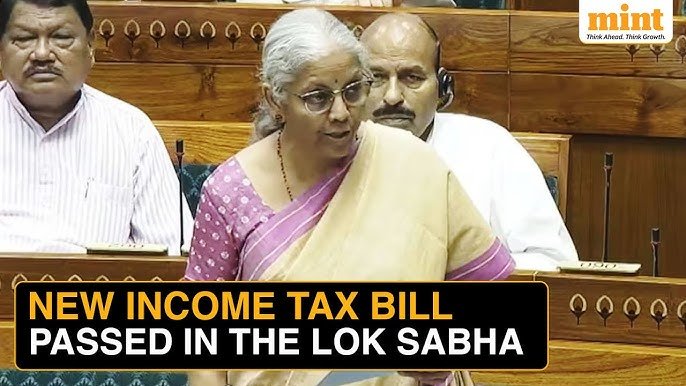
Punchline: Parliament just rewrote India’s tax rulebook in minutes — and left the country asking whether this is bold reform or bulldozed democracy.
A Historic Shift in India’s Tax Landscape
On August 11, 2025, the Lok Sabha quietly — or rather, noisily — made history. Amid opposition slogans over an unrelated voter list controversy in Bihar, the government tabled and passed the Income Tax (No. 2) Bill, 2025 in just minutes.
No debate. No detailed reading. Yet the legislation marks the most sweeping rewrite of India’s tax laws since the Income Tax Act, 1961 came into force.
The bill replaces the bulky, litigation-heavy 1961 law with a streamlined, digital-first framework — one the Finance Ministry claims will be simpler, faster, and fairer for taxpayers.
Why This Bill Is in the Spotlight Right Now
The buzz isn’t just because of the reform itself — it’s about how it was passed and what it changes:
- Middle Class Relief – A ₹12 lakh annual exemption stays intact, and the Section 87A rebate is enhanced, potentially cutting tax bills for lakhs of salaried Indians.
- Corporate & Investor Impact – Redefinitions of “capital asset,” changes to capital gains taxation, and stricter disclosure norms are sending accountants scrambling.
- Digital-First Compliance – From faceless assessments to pre-enforcement notices, the taxman’s knock will now come in your inbox — not at your door.
- Political Drama – The opposition calls the bill’s passage “bulldozing democracy,” accusing the government of skipping vital scrutiny.
Old vs New: Quick Comparison Table
| Feature | 1961 Act | 2025 Bill |
| Sections | 819+ | 536 |
| Assessment | Mostly physical | 100% faceless/digital |
| Basic Exemption | ₹12 lakh (new regime from 2023) | ₹12 lakh retained |
| Rebate (Sec 87A) | ₹25,000 max | ₹60,000 max |
| Pension Rules | Different for schemes | UPS aligned with NPS |
| Donations | Wider anonymous scope | Restricted unless social purpose |
| Refunds | Delays possible for late filing | Allowed even after due date |
Key Changes at a Glance
- Section Count Slashed – From 819 to 536 sections across 23 chapters.
- Faceless Assessments – Mandatory online proceedings to cut corruption and delays.
- TDS & Refund Reform – Refunds allowed even if returns are late; nil-TDS certificates for non-liable taxpayers.
- Pension Parity – Unified Pension Scheme withdrawals taxed like NPS.
- Anonymous Donation Rules – Restrictions unless tied to social service activities.
- Clearer Definitions – Beneficial owner, capital asset, and MSME clarified to reduce disputes.
Real-World Impact Example
- Salaried Individual – Annual Income ₹15 lakh
- Old Regime (2023): Tax liability ≈ ₹1.95 lakh after rebate.
- New Bill (2026): Tax liability ≈ ₹1.55 lakh after higher rebate — ~₹40,000 saved.
- Old Regime (2023): Tax liability ≈ ₹1.95 lakh after rebate.
- Small Business (Turnover ₹2 crore)
- Old Act: 15+ compliance filings/year, physical scrutiny risk.
- New Bill: 8–10 filings/year, faceless audits, reduced compliance cost by ~30%.
The Controversy: Reform or Railroading?
- Old Act: 15+ compliance filings/year, physical scrutiny risk.
While the Finance Ministry calls it a “taxpayer-friendly transformation,” the process has overshadowed the policy.
- No Debate in Lok Sabha – Passed amid chaos, with MPs shouting slogans over Bihar’s electoral roll controversy.
- Privacy Fears – Earlier drafts proposed wide access to taxpayer data — emails, social media, and financial accounts. Though toned down, activists say the bill still leaves room for intrusive oversight.
- State Pushback – Some states claim they were not consulted on rules affecting local charitable trusts and small businesses.
Political Voices
- Nirmala Sitharaman (Finance Minister): “This Bill makes compliance S.I.M.P.L.E and protects honest taxpayers while ensuring transparency.”
- Mallikarjun Kharge (Congress): “The government has bulldozed democracy. No debate, no scrutiny, and no respect for Parliament.”
- Industry Body (FICCI): “We welcome simplification but urge a longer transition period to avoid disruption.”
The Rajya Sabha & Legal Angle
- If the Rajya Sabha passes it without changes, the bill could be law by the end of the monsoon session.
- If amendments are pushed, rollout could be delayed to FY 2027–28.
- Legal risk: Privacy-related clauses could face Supreme Court challenges, especially if digital access powers are misused.
Public & Social Media Reaction
- #TaxBill2025 and #NoDebateDemocracy trended on X (Twitter) within hours.
- Middle-class users flooded Google with “₹12 lakh exemption new tax,” driving the current search spike.
- Memes Zmocked the speed of passage: “Blink and you miss it — your tax code is now new.”
Q. When will the new Income Tax Bill take effect?
Likely from April 1, 2026 (Assessment Year 2026–27).
Q. Are tax slabs changing?
No, the ₹12 lakh exemption and slab rates from the new regime stay.
Q. Will the old tax regime still exist?
It’s unclear — the bill focuses on the new regime, but transition provisions are expected.
Q. What is faceless assessment?
All assessments, appeals, and notices will be done digitally to reduce human bias and corruption.
Bottom Line
India’s tax code is finally getting the 21st-century makeover it needed. But in bypassing open parliamentary debate, the government may have won a legislative battle while igniting a political war.
For taxpayers, the next few months will be about reading the fine print — and preparing for a world where your taxman is more likely to email you than knock on your door.
FOR MORE BLOGS –beyondthepunchlines.com

 Add to favorites
Add to favorites







